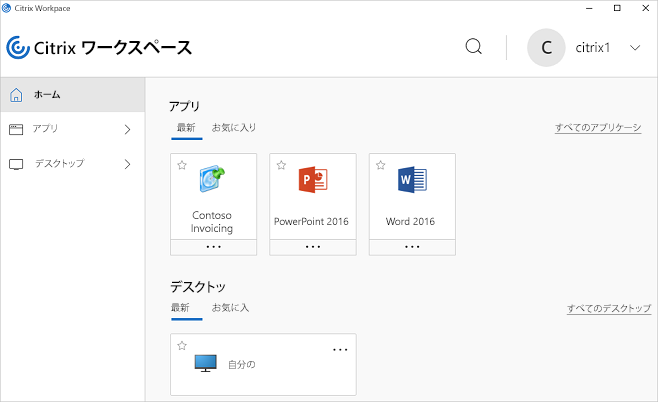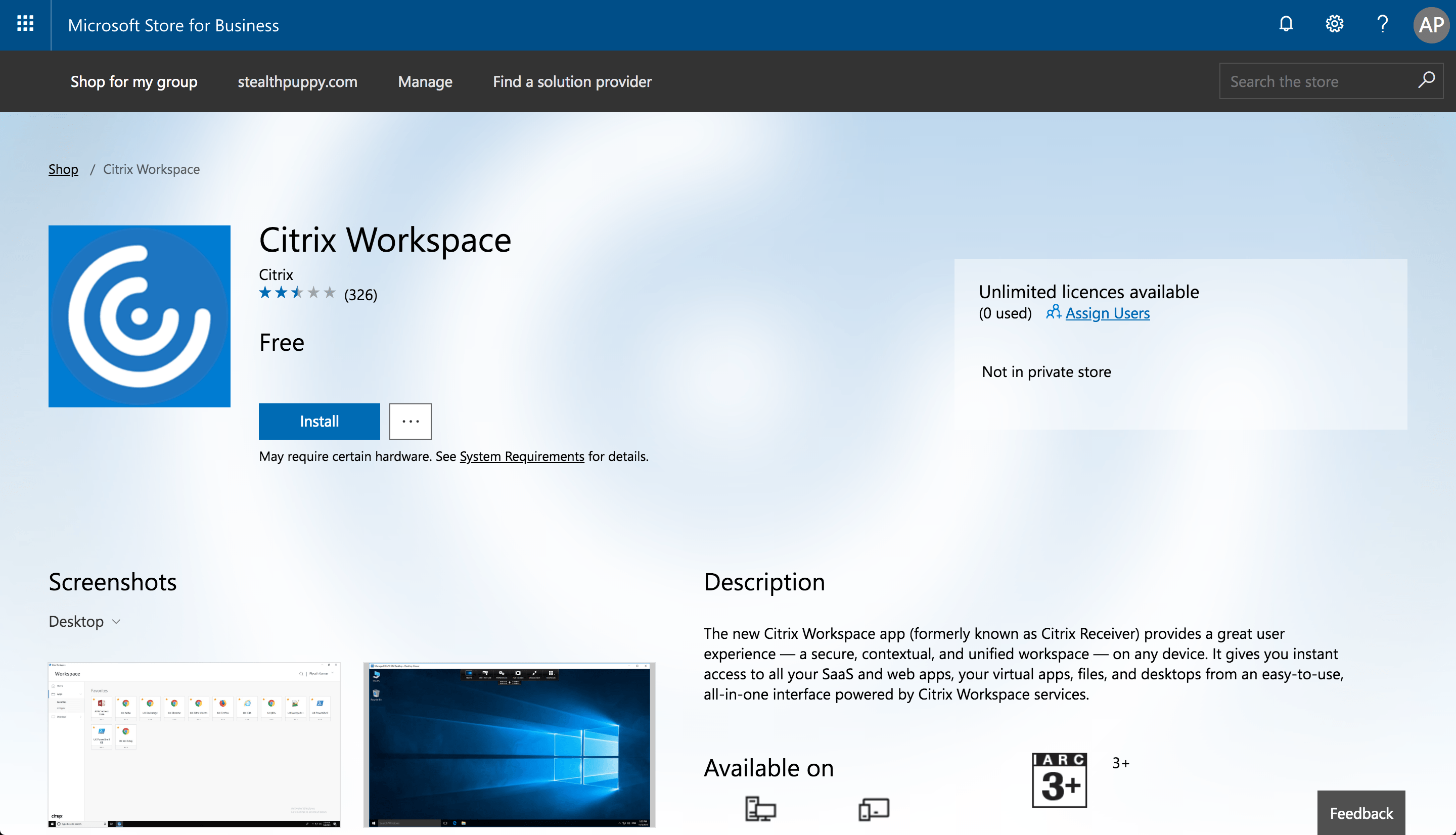Citrix Workspace Cleaning Existing Workspace App
| Developer(s) | Citrix |
|---|---|
| Operating system | Windows NT, macOS, Linux, Android, iOS, Windows Phone 8 |
| Type | Desktop Virtualization |
| License | Freeware, source-available |
| Website | www.citrix.com/products/receiver/ |
- Citrix Workspace Cleaning Existing Workspace Apps
- Install Citrix Workspace Windows 2010
- Citrix Receiver Workspace App For Windows
- Citrix Workspace Stuck On Cleaning Existing Workspace App
Citrix Workspace App (formerly Citrix Receiver) is the client component of XenDesktop and XenApp, developed by Citrix Systems. It was released initially in 2009.
Product overview[edit]
Citrix Receiver is the client component of XenDesktop or XenApp.[1] Devices with Receiver installed are able to access full desktops via XenDesktop or individual applications via XenApp from a centralized host, such as a server or cloud infrastructure.[2] The product's intended users are employees.[3]
The solution is tested and validated through the Citrix Ready HCI Workspace Appliance Program. The guide will help users deploy a turnkey, hybrid cloud, app and desktop infrastructure in a matter of hours. By enabling the HCI workspace appliance to connect to Citrix Cloud in order to automate the setup and maintenance of the Citrix Virtual Apps. I was tasked with getting our Citrix server Xenapp6.0 upgraded to a newer supported version but no one seems to be able to help, I requested from our supplier to see if they could help, They said to create a citrix account and log a ticket, I did that and sent them the file from 'My Files' folder, They came back and said please contact your local citrix agent.
Citrix Receiver is not a standalone product and is included with XenApp and XenDesktop.[4]
Reviews praised Citrix Receiver's reasonably fast loading time[5] and flexibility in allowing remote desktop access from many different computer and mobile platforms.[6] However, reviewers also criticized the iPhone version of the software for the difficulty of formatting text and prolonged typing, tasks that normally required a keyboard and mouse.[6] The iPad version had similar accessibility issues, and the performance of Flash applications was very limited.[5] As a remedy, Citrix developed a mouse for iOS devices.[7]
Update from the Citrix website:[8]
Citrix Workspace Cleaning Existing Workspace Apps
As of August 2018, Citrix Workspace app has replaced Citrix Receiver.Citrix Workspace app is a new client from Citrix that works similar to Citrix Receiver and is fully backward-compatible with your organization’s Citrix infrastructure. Citrix Workspace app provides the full capabilities of Citrix Receiver, as well as new capabilities based on your organization’s Citrix deployment.
History[edit]
Prior to Receiver, Citrix had a different client for each of its products. The company developed Receiver to handle the management of those clients.[9] Citrix Receiver was announced in 2009 and the first version became available later that year.[10] Citrix Receiver won several mobility awards after its release, including a CRN Appy and 'Best of Interop' award for Wireless & Mobility in 2011,[11] and a Global Mobile Award in 2012.[12] As of August 2018, Citrix Workspace app has replaced Citrix Receiver[13]
References[edit]
- ^Frederic Lardinois (21 August 2014). 'Google And Citrix Team Up To Launch A Better Citrix Receiver For Chrome OS'. techcrunch.com. Retrieved 25 August 2015.CS1 maint: discouraged parameter (link)
- ^Musthaler, Linda (2 December 2011). 'Citrix Receiver brings full-fledged desktop apps to smartphones and tablets'. networkworld.com. Retrieved 25 August 2015.CS1 maint: discouraged parameter (link)
- ^Weedmark, David. 'How Does the Citrix Receiver for the iPhone Work?'. everydaylife.globalpost.com. Retrieved 25 August 2015.CS1 maint: discouraged parameter (link)
- ^Ben Woods (May 27, 2011). 'Citrix expands Receiver support to one billion devices'. ZDNet. CBS Interactive. Retrieved 1 October 2015.CS1 maint: discouraged parameter (link)
- ^ abBlackwell, Gerry (July 29, 2010). 'Review: Citrix Receiver for iPad'. EnterpriseMobileToday. QuinStreet Inc. Retrieved 18 November 2015.CS1 maint: discouraged parameter (link)
- ^ abBattersby, Jeffery. 'Citrix Receiver for iPhone'. Macworld. IDG. Retrieved 18 November 2015.CS1 maint: discouraged parameter (link)
- ^Broida, Rick (May 7, 2015). 'Citrix to launch iOS-compatible mouse'. CNET. CBS Interactive. Retrieved 11 December 2015.CS1 maint: discouraged parameter (link)
- ^'Receiver'. Citrix.com. Retrieved 2019-07-10.
- ^Koetzing, Thomas (9 October 2012). 'Understanding Citrix Receiver'. koetzing.eu. Retrieved 25 August 2015.CS1 maint: discouraged parameter (link)
- ^Madden, Brian (19 May 2009). 'What's the difference between the 'ICA client,' the 'XenApp Plug-in,' and the 'Citrix Receiver?' A guide to Citrix's client names and variants'. brianmadden.com. Retrieved 25 August 2015.CS1 maint: discouraged parameter (link)
- ^'Interop's Best Of The Best, Network Concerns'. InformationWeek. 13 May 2011. Retrieved 25 August 2015.CS1 maint: discouraged parameter (link)[permanent dead link]
- ^Acharya, Sarmistha (3 March 2012). 'MWC 2012: Winners of Global Mobile Awards'. International Business Times. Retrieved 25 August 2015.CS1 maint: discouraged parameter (link)
- ^'Official website'. Retrieved 2019-02-07.CS1 maint: discouraged parameter (link)
External links[edit]
- Official website
Install Citrix Workspace Windows 2010
By default, there is a delay of about two minutes before the store is contacted. You can override this by setting the following registry keys and adjusting for Wow6432Node as appropriate:
Key | Notes |
REG_SZ HKLMSOFTWARECitrixDazzleInitialRefreshMinMs | Set to 1. |
REG_SZ HKLMSOFTWARECitrixDazzleInitialRefreshMaxMs | Set to 1. |
Shortcuts
For any subscribed application, SSP builds a Start menu shortcut that launches an HDX session for that application when the user selects it. These shortcuts persist after the user logs off from the aggregation tier. If the user selects the shortcut without being logged on, they are prompted for credentials before the application launches. There is an exception to this: if the published application is tagged with a prefer keyword that has a value matching an existing local shortcut, no hosted shortcut is created. This is to save the overhead of a hosted launch where a local one might suffice. For further details, see http://support.citrix.com/proddocs/topic/receiver-windows-40/receiver-windows-config-app-delivery.html
SSP mimics a local install by building an .exe file that causes the application to start remotely when the file is run. Shortcuts are created for the application and an Add/Remove Software entry is also built. When SSP builds a shortcut, it builds it to a small stub application in a file %appdata%CitrixSelfServiceapp-name-with-spaces-removed.exe for each resource. These files allow SSP to create a fake 'install' record for Add/Remove Software. Running these .exe files causes the application to launch. This may be the simplest launch option for scripting: look for the relevant .exe file under the user’s profile area and execute it.
If you want to drive SSP directly for launch instead of through an .exe stub, look at the keys under HKCUSoftwareMicrosoftWindowsCurrentVersionUninstall. There will be keys in there named farm-name@@server-farm-name.app-friendly-name. In these keys you'll find a LaunchString value that shows the relevant parameters. These parameters are user-independent and can therefore be cloned from a reference user to a general case.
These launchstrings will be of the form
You can copy and reuse these parameters without interpretation. This may be off-putting if the aim is to try and build a control for these independently. It is not necessary though to understand resources at this abstract level if more control is required.
Additional command-line arguments can follow the above format or be passed to the .exe stubs.
For both the stub and the direct launch methods, SSP will take care of authentication and interaction with the Web Interface or StoreFront.
Alternatively to -launch, -qlaunch, which has a simpler syntax, can be used. Please see below for details.
Cache file for resource details
A cache file is created per provider when SSP exits. This file records the last enumeration details and allows SSP to start up quickly. The name of the cache file is decorated with the internal store name.
Running the command selfservice.exe –init –ipoll –exit starts SSP, performs a refresh (interactive poll) from the current provider, and forces a clean exit. The cache file is then created in the %LOCALAPPDATA%citrixselfservice directory.
The cache file contains information about each resource, including all the information needed for a launch.
The launch command line contains:
If you look in a cache file (an example name might be storeservi-ee876897_cache.xml) you will see that it has a <resource> entry per application or desktop.
Citrix Workspace Stuck On Cleaning Existing Workspace App
To construct a launch command line from this file, use the following details:
| STOREID | The name of the file (do not include _cache.xml) |
| RESOURCEID | Contents of <internalName> |
| ICALAUNCHURL | Contents of <icaLaunchUrl> |
The cache file will contain some LaunchCommandLine entries, but only for subscribed or prelaunch resources.
There is also a dump.xml file in the same location with similar content. This file is intended for external consumption (unlike the cache file). It contains some but not all LaunchCommandLines.

Other useful SSP parameters
Note that where multiple parameters are supplied, SelfService.exe executes them in order.
Parameter | Description and notes |
SelfService.exe –logoff | Log off current user. |
SelfService.exe –rmPrograms | Clean up shortcuts and stub programs for current user. |
SelfService.exe –reconnectapps | Reconnect to any existing sessions the user has. By default happens at launch time and app refresh time. |
SelfService.exe –disconnectapps | Disconnect any current HDX sessions. |
SelfService.exe –createproviderStoreName StoreURL | Create a provider. |
SelfService.exe –deleteproviderbyname StoreName | Remove a provider. |
SelfService.exe –deleteproviderandlocalappsbyname StoreName | Remove a provider. |
| SelfService.exe –poll | Contact the server to refresh application details. |
| SelfService.exe –ipoll | Contact the server to refresh application details as in –poll, but if no authentication context is available, prompt the user for credentials. |
| SelfService.exe –deletePasswords | Remove any stored passwords. |
| SelfService.exe –exit | Exit from SelfService.exe. |
| SelfService.exe –qlaunch “appname” See Note 1. | Launch applications. |
SelfService.exe –qlogon | Reconnect any existing apps for current user. |
SelfService.exe –fastterminate | Log off the current user and leaves their applications connected. |
SelfService.exe –terminate | Disconnect applications for all users on endpoint. |
SelfService.exe –terminateuser “user_name” | Disconnect applications for a specific user. |
| SelfService.exe –logoffSessions | Log off all the active sessions for the current user Note: This flag is available only in Receiver for Windows 4.12 and later versions. |

Note 1: These parameters are available only in Receiver 4.2 and later versions.
Additional Resources
Citrix Documentation - Configure and install Citrix Receiver for Windows using Command Line parameters.
